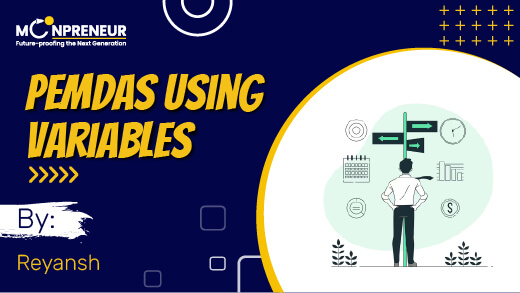MoonCampaign by Reyansh (10 years)

PEMDAS using variables
Reyansh
Show n Tell
Show n Tell
Coming Soon
Reyansh’s "PEMDAS using Variables" project creatively combines mathematics and programming to help users understand the order of operations. Using the Micro:bit’s display, the program presents math equations that users solve step by step following PEMDAS rules. By leveraging variables, Reyansh made the problems dynamic and reusable, turning learning into an engaging, interactive experience. This project not only simplifies a complex math concept but also highlights how programming can be a powerful tool for education and problem-solving.
As a student who loves both mathematics and programming, I wanted to create a project that would help others understand the order of operations in math through coding. The result was my project, "PEMDAS using Variables." My goal was to build an interactive tool that not only demonstrated the concept of PEMDAS (Parentheses, Exponents, Multiplication, Division, Addition, and Subtraction) but also helped users practice it in a fun and engaging way.
The inspiration for this project came from my own experience with learning math. I often found the rules of PEMDAS to be confusing, and I thought that coding could offer a creative solution to visualize and internalize the process. Using the Micro:bit’s screen, I wrote a program that would display mathematical equations and ask users to solve them step by step, following the PEMDAS order. I also used variables in the code to make sure that the math problems could be easily adjusted and reused.
What made this project so exciting was how it turned an abstract math concept into something tangible and interactive. By programming the Micro:bit to calculate and display the results, I was able to give users a visual representation of how PEMDAS worked in action. The use of variables allowed for dynamic problems that could change every time someone interacted with the project, making learning feel like a game.
The purpose of "PEMDAS using Variables" was to make math more interactive and fun while demonstrating how programming can be a tool for learning other subjects. Whether it’s used in the classroom or as a personal challenge, I believe this project can help students develop a deeper understanding of mathematics, all while reinforcing the importance of logic and programming in everyday problem-solving.
©️ Copyright, Moonpreneur Inc.
3031 Tisch Way, 110 Plaza West PMB # 138, San Jose, CA 95128, USA
Likes
Rating
62 days left
PEMDAS using variables